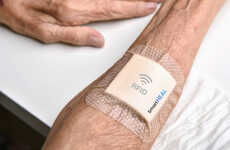
The Graphene Bandage Has Built-In Bacteria Barriers
Meghan Young — July 29, 2010 — Lifestyle
References: sciencedaily & dvice
Although I've perfected the Polysporin/Band-Aid routine when I accidentally wound myself (which, unfortunately, is more often than not), the Graphene bandage seems like a great alternative. Developed by Chinese scientists, it is a carbon-based bandage that has built-in bacteria barriers.
Since infection is the main risk with cuts and scrapes, Graphene bandage would essentially prevent that from happening. Discovered back in 2004, its antibacterial properties were only recently stumbled upon.
Since infection is the main risk with cuts and scrapes, Graphene bandage would essentially prevent that from happening. Discovered back in 2004, its antibacterial properties were only recently stumbled upon.
Trend Themes
1. Graphene Bandages - The Graphene bandage has built-in bacteria barriers, offering a disruptive innovation opportunity in the wound care industry.
2. Antibacterial Materials - The discovery of graphene's antibacterial properties presents a disruptive innovation opportunity for industries focused on creating infection-resistant products.
3. Carbon-based Medical Solutions - Carbon-based bandages, like Graphene bandage, have the potential to disrupt the medical industry by providing advanced wound care solutions.
Industry Implications
1. Wound Care - The use of Graphene bandages with built-in bacteria barriers can disrupt the traditional wound care industry by offering better infection prevention.
2. Materials Science - The discovery of graphene's antibacterial properties offers a disruptive innovation opportunity for industries focused on developing new materials with infection-fighting capabilities.
3. Medical Supplies - The development of carbon-based bandages like Graphene bandage has the potential to disrupt the medical supplies industry by introducing advanced wound care products.
1.6
Score
Popularity
Activity
Freshness























